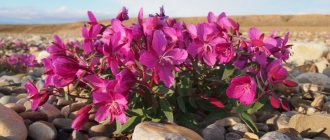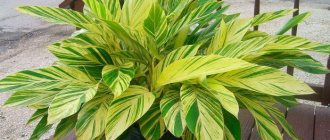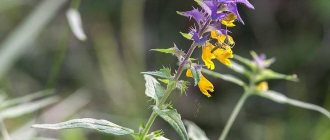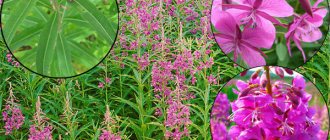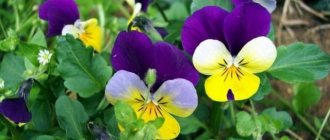Ivan tea is one of the unpretentious plants that can be found in clearings, forest edges, river banks and many other places. In the photo of the plant you can see how beautifully this amazing plant blooms. However, in addition to its visual attractiveness, Ivan tea has unusually beneficial properties for the body. Our ancestors noticed its medicinal properties. However, in modern folk medicine the plant has not lost its popularity and is successfully used to treat various diseases.
What does the plant look like and where does Ivan-tea grow? Externally, Ivan tea has light green oblong leaves and beautiful purple inflorescences. Unusual flowers can be easily seen in the photo of the plant. After the flowers fade, fluffy boxes form in their place, in which the seeds of Ivan tea ripen. Common places where grass can be found are forest clearings, meadows, river banks and waste sites.
This plant is also popularly called “fireman”. Ivan-tea received this nickname due to the fact that the plant is the first to appear in areas after a fire. Also, many call it “fire grass.” Due to the plant's belonging to the fireweed family, the herb is also called "fireweed".
Plant composition
Ivan tea has an incredibly rich biochemical composition. The presence of many useful substances ensures its benefits and effectiveness for the treatment of various ailments. So, fireweed includes the following components:
- vitamins;
- vitamin A analogues - carotenoids;
- pectin;
- useful acids;
- flavonoids;
- tannins;
- alkaloids.
A description of the plant would not be complete without mentioning the presence of polysaccharides and phytosterols and a huge variety of vitamins and microelements that are extremely beneficial for the human body. The plant contains zinc, potassium, boron, nickel, calcium and many other substances.
Ivan tea contains an extremely large amount of ascorbic acid. Here it is 5-6 times more than in lemons and oranges.
Fireweed has enormous beneficial properties for the human body. Tea not only has a beneficial effect on all human systems and organs, but also has an incredible taste. Today, the varieties of Ivan tea are very wide. It can be found both in its pure form and with the addition of various other useful plants. So, what are the benefits of tea for the body?
- Regular consumption of tea has a positive effect on a person’s immunity and overall well-being.
- With this drink you can get rid of harmful substances such as waste and toxins. The components of the plant have powerful antioxidant properties.
- For anemia, Ivan tea is also indispensable. The drink significantly improves blood composition and increases hemoglobin.
- Drinking tea allows you to normalize all metabolic processes in the body.
- Fireweed also has a positive effect on the organs of the endocrine system.
For colds, drinking tea has anti-inflammatory, antiviral and antiseptic effects. Tea is indispensable for both the treatment and prevention of flu and colds. The properties of Ivan tea also include:
- Fireweed has a beneficial effect on the psycho-emotional state of a person. Drinking the drink helps relieve stress, calm down, get rid of worries, and normalize sleep.
- Tea is also extremely beneficial for the digestive system. It has diuretic, choleretic properties, eliminates inflammatory processes of the stomach and other gastrointestinal tract organs.
- When the temperature rises, you can take slightly warm tea; the drink helps relieve fever and saturate the body with healthy vitamins.
- Fireweed works great for various types of pain. For headaches, toothaches or any other pain, it is recommended to drink the product warm 3-4 times a day.
- For sore throat, tonsillitis and various colds, it is recommended to gargle with a decoction of the plant 3-4 times a day.
Varieties of fireweed and photo of the plant
Fireweed, growing in our country, has about 14 species, the following plants are considered the most common.
Narrow-leaved . The perennial plant grows up to 1.5 meters. The variety has a powerful root system and an erect stem, which bears a large number of shiny, finely toothed leaves. The inflorescences are large, pink-purple, and there are also plants with white inflorescences. Flowering begins in mid-June and lasts until the end of August.
Legend has it that Pyotr Badmaev, a doctor and scientist who devoted his life to the study of narrow-leaved fireweed, lived for 110 years. It is noteworthy that his youngest daughter was born when the doctor was already 100 years old!
Broadleaf. Grows in the north. It differs from other varieties in its foliage, which reaches a length of up to 10 cm and has rounded or pointed ends. The flowers of the plant are dark pink, collected in a brush. Eskimos add the plant to their food, and in Greenland it is considered the national flower.
During the reign of Peter I, a drink made from fireweed tea entered the world market and in the 18th–19th centuries became so famous and in demand that it competed with the East Indian tea campaign
Caucasian. This variety grows along the banks of rivers and lakes, on pebbles, in fields and meadows. The species is low, reaching up to half a meter in height.
The plant has creeping stems and linear-lanceolate leaves. The inflorescences are short and bright purple. The variety looks beautiful when cut.
In Rus', in terms of popularity of export, coporka took 2nd place, ahead of seemingly the most popular goods: hemp, furs, gold
Dodonei . The perennial plant grows up to 90 cm in height. It has a decorative appearance thanks to its finely branched stems and white or purple inflorescences. The variety is most often found in the middle and subalpine zone, in meadows and fields.
At the end of 1941, postponing their fierce attack on Leningrad for a day, on Hitler’s orders, German troops were sent to Koporye. Tea plantations, scientists, developments, production and manufacturers - everything was destroyed!
Steven . The species has small leaves up to 3 mm wide and bright inflorescences in the form of an elongated raceme.
Fireweed seeds have an unusual feature - they are covered with down. Due to this and their lightness, they move over considerable distances.
Fleicher . A small herbaceous perennial that grows up to half a meter. The species has a powerful rhizome and numerous stems, which are hung with small pointed leaves. The plant produces bright pink or purple flowers. The species is frost-hardy and blooms all summer.
This plant can be brewed up to 5 times, and it will not lose its healing properties.
Colchis . Grows in the Caucasus, in the mountains and on highlands. The plant is low with pale pink bright flowers.
Fireweed contains 70 different microelements, which makes up more than half of the periodic table
All varieties of fireweed, due to their decorative appearance, are often grown in personal plots, since the plant not only decorates the garden, but also helps with many diseases.
It contains 6 times more ascorbic acid than lemon, and more antioxidants than red wine or green tea.
Plant collection
When to collect Ivan tea? To independently prepare medicinal raw materials, the plant is picked during its flowering period. To do this, flowers and grass leaves are cut. It is recommended to leave the roots in the ground. You can collect flowers and leaves separately. It is also worth noting that if the plant is not collected during its flowering period, it will not have beneficial properties.
The plant is dried in several ways. In the first case, flowers and leaves are laid out in a well-ventilated area on paper napkins or regular newspaper. After drying, the raw materials are crushed and stored in bags made of natural fabric.
The second method is more complicated. To do this, the grass is lightly dried for 10-12 hours, then rolled into thin tubes and placed in a bowl, covered with a wet cloth. The plant is left in this form for a few more hours. The final step is to dry the leaves in a slightly preheated oven. Afterwards, the raw materials are stored in bags or paper bags. It is not recommended to store the plant in glass or tin.
There are plants similar to Ivan tea (see photo). When harvesting herbs, it is important not to confuse them with real fireweed.
How to brew tea?
The recipe for brewing fireweed is quite simple, but it is still different from preparing regular tea. So the procedure is as follows:
- You can prepare tea in both glass and ceramic containers. During the brewing process, you can feel the incredibly pleasant aroma of the drink and its stunning color.
- Herb at the rate of 2 tablespoons per 500 ml. water is poured with boiling water and left to brew under a closed lid for 10-15 minutes. The drink is considered ready when the leaves completely settle to the bottom.
- The water for preparing the drink must be of high quality, without the addition of various impurities. Various additives can affect the taste of the drink.
- Before pouring the tea into cups, the contents of the teapot should be stirred again.
You can also brew tea in a thermos. This method will allow you to experience the taste of the plant even more strongly. To do this, place 2 or 4 tablespoons of herbs in a thermos with a volume of 0.5 or 1 liter and fill it with boiling water. The lid of the thermos should be tightly sealed and the drink should be left to brew for 2-3 hours. You can drink tea with sugar or chalk to taste.
Traditional medicine recipes
In addition to brewing as tea, fireweed is also used in some traditional medicine recipes. The following methods are popular.
Treatment of the digestive system
To prevent and treat diseases of the digestive system, it is recommended to prepare a concentrated infusion from the leaves and flowers of the plant. To do this, pour a tablespoon of herbs into a glass of boiling water and cover with a lid. Infusion time is 20-30 minutes. Take half a glass in the morning and evening.
Healing remedy for burns and wounds
To prepare the medicine, place a tablespoon in an enamel container. l. plants and fill it with 500 ml of cold water. Bring the mixture to a boil over low heat and cook for another 15-20 minutes. After cooling, the decoction is used for rubbing and bathing.
Cure for psoriasis and other skin problems
Fireweed leaves (2 tbsp.) must be ground into powder and mixed with one tsp. Vaseline. The ingredients should be thoroughly mixed and added to 10 drops of sea buckthorn oil. The resulting ointment is applied to the affected areas several times a day for 20-30 minutes.
The use of fireweed for diseases
Due to its medicinal properties, the plant is used for the treatment and prevention of many diseases.
Gastrointestinal tract and genitourinary system
Proven recipes for gastrointestinal diseases:
- Infusion from the plant for peptic ulcers of the stomach and duodenum . Brew 200 g of dried herb with a glass of boiling water and leave for several hours. Strain the infusion and take one tablespoon 3 times a day.
- For gastritis and colitis . Pour 15 g of dry leaves into 250 ml of water and boil over low heat for 15 minutes. Cool the broth and strain. Take a tablespoon 4 times a day.
- For pancreatitis . Pour 3 tablespoons of dry grass into 300 ml of water. Close the lid and leave for 10-15 minutes. Take 50 ml before and after eating.
Allergy sufferers are not recommended to take infusions.
Recipes for diseases of the genitourinary system:
- Oncology of the genital organs . Mix fireweed flowers, nettles, plantain, knotweed and acacia flowers in a ratio of 2:2:2:1:1. After preparing the herbal mixture, take 2 teaspoons of herbs and pour 500 ml of boiling water. After straining, drink a glass in the morning and evening.
- Kidney diseases. Mix fireweed flowers, yarrow, marsh cudweed herb, celandine and crushed rose hips in a ratio of 3:3:2:1:4. Take a tablespoon of the resulting herbal mixture and brew it in a glass of boiling water for about an hour. Drink ⅓ glass three times a day, warm.
Nervous system and headaches
Problems with the nervous system are not uncommon these days. Stress at work, climatic conditions, worries - all this leads to sleep disturbances, migraines, depression and stress. To get rid of these ailments, Koporye tea comes to the rescue.
Calming drink. Brew a teaspoon of flowers and leaves with 500 ml of boiling water. Leave for 10-15 minutes, cool, strain and take a tablespoon 3 times a day.
For insomnia. Pour 250 ml of boiling water into a tablespoon of herbs. Leave for 2 hours to infuse. Strain and take 20 ml three times a day for 2.5 months. After that we do a monthly interval and resume taking it.
For headaches. Pour a tablespoon of dry fireweed into a glass of boiling water and leave to steep for 2 hours. Afterwards, filter and consume a tablespoon three times a day before meals.
Fireweed can relieve nervous tension
Prostate adenoma and prostatitis
Ivan tea can help with prostatitis and prostate adenoma only in the initial stage of the disease. How to brew Ivan tea correctly:
- Infusion . Take a teaspoon of leaves and pour a glass of boiling water. Let the infusion steep for half an hour. The prepared solution must be drunk in one gulp. Course of admission: twice a day for 20 days.
- Decoction . Pour 4 tablespoons of chopped herbs into 300 ml of water. Bring to a boil and simmer for no more than 3 minutes. Take warm or hot 2-3 times a day for 15 days.
Experts recommend preparing a decoction, as it is most effective in combating acute infections in men.
Fireweed for prostate disease (video):
Hangover syndrome and reduction of cravings for alcohol
A hangover syndrome is accompanied by a feeling of anxiety and sleep disturbance.
Ivan tea after a stormy “party” relieves headaches, normalizes the mental and emotional state, and restores vitality. Recipes that will quickly relieve a hangover:
- Pour 2 teaspoons of dry herb into 500 ml of boiling water and leave to steep for 15-20 minutes. Take 3-4 times a day;
- We take fireweed and thyme in a ratio of 5:2 and brew it in a teapot like regular tea. Take up to 6 times a day;
- 5 g of fireweed and 2 g each of wormwood and mint. Mix the herbs, take a tablespoon and pour in 0.5 liters of water. Place the broth on low heat and simmer for 5-10 minutes. We consume 70 ml in strained form three times a day.
Ivan tea is an additional remedy in the treatment of alcoholism
Ivan tea for weight loss
Fireweed can be found throughout Russia, but not everyone knows that such a beautiful and widespread plant has many healing properties. One of them is weight loss. A drink made from fireweed
- Reduces appetite.
- Improves food digestion.
- Has a diuretic and laxative effect.
- Normalizes cholesterol levels, also breaks down fats and affects the hormonal system.
Fireweed relieves swelling
Recipes for weight loss:
- Take a tablespoon of dry grass and pour 500 ml of water. Bring to a boil and simmer for 10 minutes. Add ¼ teaspoon of ground cinnamon and lemon juice to taste to the prepared solution. We take 250 ml of ready-made tea every morning before meals for 7 days;
- Take leaves of fireweed, currants and strawberries in equal parts, mix everything. Pour 4 tablespoons of herbs into 500 ml of boiling water. Place the prepared solution on the fire and boil for no more than 10 minutes. Strain, cool and take up to 3 times a day.
In skillful hands, using drying or fermentation, you can get a drink of any color you want: white, green, black, red
Contraindications
In some cases, the use of Ivan tea and medicines based on it is strictly prohibited. Contraindications include:
- Pregnancy and lactation period.
- Children under 6 years old.
- People with personal intolerance to plant components.
- Patients with high stomach acidity.
Before drinking tea, it is very important to consult a specialist. This will help eliminate many complications and side effects.
Ivan tea can be called a real gift from nature, because a healing drink that improves health is prepared from this plant, which is also called fireweed.
Ivan tea grows in all regions of our country. In this case, the plant does not grow alone, but forms quite extensive thickets in the form of a flower carpet.
To make healthy tea from fireweed, you should know in advance what this perennial looks like. And since the collection is carried out during the flowering period, it is especially important to be able to recognize fireweed flowers.
Height
This herbaceous plant can reach two meters, but most often in nature there are specimens of fireweed with a height of 0.5 to 1.5 meters. Ivan tea has a rather thick rhizome with a dense brown-yellow skin. Buds quickly appear on it, so the plant is propagated by parts of the root planted in the garden plot.
Stem
Ivan tea is straight, it has a rounded shape and is densely covered with leaves that have short petioles. The leaves of this plant are long - from 4 to 12 cm in length. Their shape is lanceolate and the ends are pointed. The edges of the leaves can be either whole or with small teeth. The color of the leaves above is dark green, and their lower surface is often bluish-green, although reddish and pink (less often) shades are also found.
Flowers
Ivan tea has a diameter of approximately 3 centimeters. Their color is lilac-red or pale pink, although there are also plants with white flowers. These large flowers are collected in inflorescences-brushes, the length of which reaches up to 40 centimeters. Fireweed begins to bloom in the second half of summer. Flowering lasts about a month.
Fireweed (lat. Epilobium) is a tall perennial herb or subshrub of the fireweed family (onagraceae). The plant has a straight stem reaching a height of up to 1.5 m
. The leaves are large, sessile with a pointed top, the flowers are dark pink. The fruit is a capsule. The peculiarity of the fireweed plant is a crest with fluffs, with the help of which the plant spreads. Fireweed begins to bloom in summer, from June to August.
Description
Fireweed (Chamaenerion) is a representative of the fireweed family. The second name of the plant is narrow-leaved fireweed (Epilóbium angustifolium). This native Russian herb grows throughout Russia, even in Siberia.
The plant has many common names. “Willow grass” (due to the similarity of fireweed leaves with willow leaves), “fire grass” (the plant is the first to settle in place after a fire), “creaking grass” (when the grass is pulled out, a corresponding sound appears).
Forgotten names include “wild flax” - ropes were woven from the fibrous stems, fabrics were made, “down jacket” - for the fluff released during flowering. Down was used to make cotton wool for pillows and mattresses. There is also a name – “breadbox”: the roots of fireweed were dried and ground, added to flour when baking bread.
Fireweed is a perennial flowering herbaceous plant with a powerful root system. The creeping rhizome has many buds that promote rapid reproduction. The height of the erect stems varies from 50 to 150 cm. The stem is densely covered with linear-lanceolate leaves.
Small pink-lilac flowers are collected in a loose cluster at the top of the plant. The length of the flower panicle ranges from 10 to 45 cm. Flowering begins in late June - early July and lasts 35-50 days. At this time, a pleasant honey aroma wafts near the flowering meadow. Fluffy capsule fruits ripen by September.
Fireweed quickly settles in sunny areas: forest clearings and edges, near reservoirs and along roads, in fire areas.
Application
The plant contains a large number of substances useful to the human body: flavonoids, ascorbic acid, tannins, starch, sucrose, essential oils, tannin. Fireweed has a wound-healing, anti-inflammatory, sedative, enveloping, hemostatic effect. In addition, fireweed acts as a laxative.
For treatment purposes, not only the leaves and inflorescences are used, but also the roots of the plant. It is recommended to use infusion and decoction of fireweed for nervous disorders
: for stress, insomnia, headaches. Due to its enveloping effect, the herb is used to treat the gastrointestinal tract (gastritis, ulcers, dysbacteriosis). Fireweed is effective for anemia, heavy bleeding, and also in the postpartum period. It is known that the plant improves metabolism, increases immunity and cleanses the body of toxins. To keep the body in good shape, the plant is brewed and drunk throughout the day as tea. It has an amber color and a pear flavor.
Ivan - tea (lat.Chamerion) is a perennial plant, belongs to the fireweed family (onagraceae). The most common type is Ivan-tea angustifolia.
(lat.Chamérion angustif%u0F3lium), popularly it is called “fireweed”, “Koporo tea”, abroad it is known as “Russian”, “heroic” tea. This drink is considered a traditional Russian herbal drink. The plant got its name from the village of Koporye, located near St. Petersburg. It grows in clearings, edges, clearings, and grows in empty places.
Ivan-tea angustifolia
Koporye tea has a calming effect on the entire body
, reduces excitability. Even in Ancient Rus', healers knew about its antibacterial effect and treated many diseases with it. The herb treats diseases of the oral cavity (tonsillitis, gingivitis, stomatitis), and the genitourinary system (cystitis, chronic prostatitis, prostate adenoma). The Ivan tea plant contains a large amount of vitamin C, its content even exceeds that of citrus fruits. The herb is taken not only internally, but also externally on wounds in the form of lotions and dressings.
The herb contains substances such as caffeine, uric acid, oxalic and puric acids. Herbal tea is not addictive. Ivan - tea is not contraindicated for pregnant and lactating women, as it has no side effects, but you should consult a doctor before use. Young leaves can be eaten.
Why is Fireweed called Ivan - tea? There is a legend about a young man whose name was Ivan and who always wore a bright crimson shirt. When he walked in the field, people said: “Tea, Ivan is walking.” Somehow the guy disappeared and was never seen again, only when the fireweed bloomed in the meadows did people in the villages remember Ivan. Since then, fireweed has been popularly called Ivan - tea.
In fact, Ivan - tea and fireweed - are one plant
, they differ only in the variety of representatives of the fireweed family. For example, marsh fireweed is found in damp places and has small dark purple flowers. Its therapeutic effect differs from Ivan tea. Another representatives of wild fireweed and wild fireweed are not used for medicinal purposes. They are distinguished from Ivan tea by external features: the stem reaches a height of up to 15 cm, and the flowers are dark purple.
Contraindications
Fireweed is contraindicated for people with high blood pressure, children under 5 years of age and those with individual intolerance.
Collection and drying. How to make healthy tea.
The leaves of the plant are collected during the flowering period in mid-June, in dry weather and preferably in the morning. There are two ways to collect leaves:
The stem is cut off and the leaves are torn off. The stem is held between the fingers and passed with the hand from top to bottom.
After washing, the grass is dried in a dry place on paper or thick cloth for no more than a day.
.
After drying, the leaves must undergo fermentation, that is, produce cell sap. Fermentation promotes a rich and floral flavor. This is done like this: the withering leaves are rolled into tubes with the palms to release the juice, then they are laid out in an enamel bowl and covered with a damp cloth. Keep warm for 8-20 hours
, at a temperature not higher than 25-27°C.
The final stage is oven drying.
. First, the leaves are finely chopped with scissors. Dry in the oven at a temperature of 50-60°C for 1-2 hours with the door open. The finished leaves resemble a mixture of green and black tea. Store in iron or glass containers. To improve the taste, it is necessary to stand for a couple of weeks.
Brewing rules
To make tea fragrant and tasty, you need to prepare it correctly. To begin with, pour boiling water over the kettle several times, add 2-3 teaspoons of tea and add boiled water. Let it brew for 10-15 minutes and you can enjoy the drink. Tea can be brewed several times without losing its beneficial properties.
Fireweed hairy
Hairy fireweed is the largest and most visible representative of the genus Fireweed. Description and photo of fireweed, its differences from fireweed
Hello dear reader!
The name of the plant “fireweed” is strongly associated with fireweed. Although from a biological point of view this is not true. Botanists have long ago separated fireweed into a separate genus with the same name (Chamerion in Latin).
Most of our fireweeds are significantly inferior to narrow-leaved willowherb both in size and, especially, in the size of flowers. I have already written about rose fireweed. And there are also marsh fireweed, small-flowered fireweed, mountain fireweed and others.
The most similar to fireweed is fireweed. It is not inferior in size, sometimes reaching the height of a man, and its flowers are the largest among the representatives of the Cyprus genus. But fireweed and fireweed have many important differences.
Shoots of hairy fireweed grow up to 1.5 meters
Hairy fireweed: description, photo. Differences from fireweed
Hairy fireweed grows on excessively moist soils: along the banks of rivers, lakes, streams, in damp meadows, ditches. In the forest it can be found in damp clearings and forest roads. It can also be a weed - it grows in waterlogged areas of fields and vegetable gardens.
Ivan-tea angustifolia, quite indifferent to soil conditions, can be found in the same places, even nearby. But on dry sandy soils, which are very popular with fireweed, hairy willowherb will not live.
Blooming fireweed
Hairy fireweed (Epilobium hirsutum) is a rhizomatous perennial, a European species characteristic of countries with temperate climates. It was accidentally introduced by humans to North America and Australia, where it poses a serious environmental problem, displacing native plant species. In Russia, hairy willowherb is common in the forest belt of the European part, in Western Siberia.
The stem of this fireweed is highly branched. In height, the plant can reach almost human height. In this case, the thickness of the stem reaches almost a centimeter.
On the stem, peduncles, leaves, and fruits, pubescence is noticeable, which is why hairy fireweed got its name. True, you can detect “hairiness” only by looking closely. There are long hairs, but thin and soft, and there are also short, glandular ones.
Hairy willowherb has noticeable pubescence on the stems and leaves
I would say that the “shaggyness” of the hairy fireweed is manifested only in comparison with other representatives of the genus, in which it is not so pronounced.
This is the difference from Ivan tea. It doesn't have any hairs on its stem.
The leaves of the fireweed are lanceolate and arranged oppositely (except for the topmost ones - they are alternate). The edge of the leaf is finely toothed. The leaves are sessile, their base encircling the stem. Leaf blades are pubescent.
Hairy fireweed leaves
Differences: fireweed has alternate leaves; there is no pubescence; the edge of the leaf is smooth.
Hairy fireweed blooms in July – August. Its flowers are arranged singly on peduncles growing in the axils of the upper leaves.
Flowers and fruits of fireweed
Angustifolia fireweed flowers are collected in clusters at the tops of the main and side shoots. Such brushes are not observed in hairy fireweed.
The flower of the fireweed is larger than the flowers of other representatives of the genus. The diameter of the flower can reach 2 - 2.5 cm - five times larger than the pink fireweed flower.
The flower of the hairy fireweed is similar to the flowers of other fireweeds, but larger than them
The structure of the flower is the same as that of other fireweed (including fireweed) - 4 narrow sepals, 4 petals, 8 stamens and a pistil with four stigmas. The petals at the top are divided into two lobes by about a third (this is already a distinctive feature of the Cyprus genus). The color of the petals is dark pink, purple, and occasionally white.
The color and size of the flowers of hairy fireweed are similar to the flowers of fireweed. But the petals of fireweed are usually rounded at the top, not dissected. And if such a dissection does sometimes occur, then it is only intended.
In August–September, hairy fireweed bears fruit. Its fruits are long tetrahedral boxes (up to 10 cm), similar to some kind of pods, but opening with four doors. The capsules contain many small seeds equipped with off-white hairs.
There are no big differences in the structure of the fruits from fireweed.
In the soil, fireweed has a thick but short rhizome (willowherb has a long rhizome). With such a rhizome you won’t spread particularly far!
Hairy fireweed solves the problem of dispersal and vegetative propagation in a different way. At the end of summer, new, shortened shoots begin to grow from growth points located at the border of the shoot and rhizome. These shoots grow horizontally. They bear rudimentary rosettes of leaves that give rise to new plants. After new shoots take root, these formations die off. It is more correct to call them stolons.
Shoots-stolons of hairy fireweed grow by autumn
These shoots are both aboveground and underground. Aboveground shoots - stolons are reddish, underground - white.
Underground shoots-stolons are white
It is clear that fireweed does not have such formations - it does not need them, it has long horizontal rhizomes. But this method of vegetative propagation does not allow the fireweed to spread far. And the plant does not form extensive thickets like those of narrow-leaved fireweed.
What else can you add? People practically never use fireweed. Beekeepers do not consider it a good honey plant. Although bees do visit flowers, I have observed them myself. The plant is not used for medicinal purposes. It is not found in reference books on traditional medicine.
Fireweeds are not poisonous. If desired, the young leaves can probably be eaten. But nothing is known about the food use of fireweed.
But it is quite possible to use the plant to decorate artificial reservoirs. Yes, it can settle on its own on the shore of your pond!
Let's summarize. Hairy fireweed is by no means a “type of fireweed,” as is sometimes claimed. This is a separate species, even belonging to a different genus of fireweed than fireweed. You can say - here it is, real fireweed!
Best regards, Alexander Silivanov
Subscribe to news? Click on the picture!
By clicking on the picture, you consent to the newsletter, the processing of personal data and agree to the privacy policy
Multifaceted taste of Ivan tea
However, in 2013, having tried Ivan tea as a guest in the Krasnodar Territory, G. Maidantsev’s opinion changed dramatically. The tea had a surprisingly pleasant aroma, similar to a flowering meadow. And it had a special taste.
Having asked the owners why their fireweed turns out to be so tasty, he learned that the leaves are fermented, and the drink is made according to the ancient Russian tradition. The taste greatly depends on the length of fermentation.
When brewed again, the drink is just as aromatic as when brewed for the first time.
It remains bright and pleasant.
Admiring the beautiful carpet of bright red, pale pink, yellow and white wildflowers, many do not even suspect that in front of them is real fireweed. From this wonderful plant, dried and fresh, medicinal teas are brewed and medicinal tinctures are prepared for many ailments.
Now, knowing what the herb Ivan tea looks like in the photo, you can recognize it yourself during a country walk and prepare it for the whole year.
What does fireweed look like?
The scientific name of fireweed is fireweed, chamenerium or chamenerium angustifolium. There are about a hundred popular synonyms for this herb: Mother of God grass, willow grass, magpie eyes, hoof grass, Koporye tea, wild flax, wild violet, field cornflowers, field sage, sweet clover, cobbler, wheatgrass, etc.
The leaves of this plant look like long knives. Botanists call this oblong shape lanceolate (reminiscent of the shape of a medical scalpel or lancet).
The pointed, shiny leaves are finely serrated at the tips and taper towards the base. Leaf petioles are most often short. The leaves are two-colored. Their surface facing the sun is dark green, and the reverse side can be gray, purple-red, and sometimes pale pink.
Inflorescences are collected in brushes. The fruit of fireweed is a small, pubescent capsule. The seeds in it are oblong, with thin long white hairs.
When collecting fireweed, mark the place where you found it. Why? Because this plant is a perennial, and next year you will find new fireweed glades here.
Its thick, succulent rhizome resembles the creeping root of mint or elderberry. The straight, thick stem is densely covered with leaves.
On favorable soils, fireweed often reaches a height of two meters. On average, the height of its stem with inflorescences is about half a meter.
Description of the monarda
This is a perennial plant. It can have a height from 50 centimeters to 1 meter and above. The stems are straight, tetrahedral with villi, the leaves are slightly drooping down, up to 10 centimeters long. They grow opposite each other, on small petioles, red in color. They are oval in shape, jagged closer to the tip, and covered with small fibers. If you touch it, you can immediately smell a very pleasant smell, reminiscent of the aroma of citrus and mint combined.
Monarda flowering
The flowers are not very large, up to 6 centimeters in diameter, the inflorescence is capitate. The fruit, once dry, can usually crack and 4 nuts will appear. It blooms for almost 2 months and has an attractive decorative appearance. The aroma of flowers resembles the smell of bergamot, which is why monarda is often called garden bergamot.
Where to look for fireweed?
Fireweed grows in dry, sandy areas of soil, in light, unshaded groves, often in clearings and fires. Therefore, the plant is sometimes also called “fireman”.
Chameneria spreads along country roads, highways, and railway embankments.
Road workers plant this plant to strengthen roadsides and slopes. But you should not collect grass in such places, because its leaves accumulate dangerous substances from the exhaust gases of car and locomotive engines.
Chamenerium blooms in June-August. Its fruits, suitable for medicinal preparations, ripen in late summer and early autumn: in the south - in August, in the north - throughout September.
Tea plantation in the garden
If you have a suburban area, then you can plant fireweed in your garden. To do this, dig up fireweed along with a lump of earth and plant it in the garden along the paths in places well lit by the sun.
From this multi-colored grass you can create wonderful flower arrangements, which landscape designers take note of.
Ivan tea is characterized by increased growth and spread activity. Therefore, think in advance about how to limit the spread of its roots.
In addition to teas, fresh young shoots and leaves can be used to prepare vitamin-rich salads. And boiled shoots can be eaten along with vegetables.
Bees love to collect fireweed nectar because it contains a lot of fructose and glucose. Honey from fireweed tea turns out to be unusually fragrant, watery-transparent in consistency, with a greenish tint.
Ivan tea, growing in natural habitats, can be found in a clearing, in a meadow, on the edge of a forest, on the bank of a river. Many people treat it as just a beautiful weed plant, but it contains a large amount of vitamins and minerals and is a medicinal plant known since ancient times. But, at the same time, there are flowers similar to fireweed, so you need to know how to distinguish them from each other so as not to harm your health during the treatment process.
Ivan tea is a well-known medicinal plant with an original appearance.
Care and breeding of monarda
There is no need to cover the plant for the winter; it usually tolerates winters well; it can grow in one place for about 10 years. They are most often propagated by dividing the bush. It expands greatly over the summer, so in the fall or spring it can be divided into 3 parts and planted. We also plant seedlings in the spring in a permanent place of growth with seeds that germinate well at home.
The plant needs feeding; you can apply Kemira fertilizer 2 times a month, water it with Gummi or mullein. Monarda loves abundant watering. It is best to plant in a sunny place, it can also grow in partial shade, only the plant turns out to be almost 2 times shorter and with a small number of flowers. But it does not lose its medicinal and aromatic properties.
Monarda looks beautiful among asters, daylilies and coniferous shrubs. This plant is almost not affected by various diseases, due to the presence of essential oils in its composition.
Description of fireweed
Fireweed (Epilobium angustifolium) narrow-leaved fireweed or Koporye tea is a herbaceous perennial plant belonging to the fireweed family. People also call it weeping grass, field sage, mulberry, sage and several dozen other names. It is distinguished by its unpretentiousness and attractive appearance. Its straight, smooth stems reach one and a half meters in height. The jagged, shiny, dark green foliage is lanceolate in shape. Depending on the location of growth, the lower part of the leaf may have a bluish-green, reddish-purple or pinkish tint.
Flowering fireweed begins in mid-summer. The flowers of the plant can be white, pink or lilac-purple and have a diameter of 4 to 12 centimeters. They gather in large pyramidal-racemose inflorescences at the tops of the stems.
When the flowers of fireweed are in full bloom, they are collected along with the leaves to prepare medicinal raw materials. After drying, they are used to prepare medicinal products or simply for brewing tea.
Plants similar to fireweed include, first of all, clarkia (elegant, pretty, pleasant), Californian fuchsia, Gaura biennial, and evening primrose. Despite some similarities, they also have a number of significant differences from fireweed.
Clarkia graceful or marigold (Clarkia unguiculata or Clarkia elegans Douglas) belongs to herbaceous plants of the fireweed family. Unlike fireweed, it is an annual plant that grows no higher than 90 centimeters and has oval-shaped bluish-green foliage with pronounced reddish veins and sparsely jagged edges. Its straight stems are lightly pubescent and strongly branched.
Flowering of the plant begins in June and lasts until mid-autumn. The flowers can be white, hot pink, salmon, red, purple, blue, lilac or violet and have a diameter of no more than 4 centimeters. Like fireweed, they are collected in racemose inflorescences located in the upper part of the stems. Clarkia graceful has varieties that have double flowers.
Clarkia pulchella is a herbaceous perennial that reaches no more than 60 centimeters in height. On its erect, branched stems there is a large amount of narrow, long, oval-shaped foliage. It is pointed towards the tip and slightly narrowed towards the petiole.
The flowers are lilac in color; they are not collected in inflorescences like fireweed, but are arranged singly or in groups in the axils of the foliage at the tops of the stems. Depending on the variety, they can have either a simple or terry shape.
Clarkia amoena or pleasant godetia is a small fireweed plant with a very attractive and elegant appearance. Its height does not exceed 30 centimeters. The stems are strewn with small gray-green foliage, ovate-lanceolate in shape and up to 5 centimeters long. The flowers, reminiscent of small roses, can be white, red or variegated with various spots and stripes, their diameter does not exceed 5 centimeters. There are varietal hybrids of pleasant clarkia with a simple and terry shape.
Fuchsia Californian
California fuchsia (Zauschneria), hummingbird or hummingbird flowers is a very drought-tolerant perennial of the fireweed family. As the name suggests, California is considered the plant’s homeland, where it thrives in the wild and blooms on rocky soils and rocks in extreme heat.
It is an ampelous form, and its flowers are bells of a very unusual shape and orange-red color. They have 4 large, slightly loose petals and 8 long red stamens. Some varieties have additional oddly shaped petals in the middle. The plant consists of stems that reach up to 60 centimeters in height. They have slightly pubescent leaves with a grayish-green tint.
Learn and care for the plant.
A little information about Ivan tea
What the fireweed plant looks like: it has a large root and an absolutely straight stem that reaches a height of a couple of meters. It has large leaves and incredibly beautiful pink or red flowers. It blooms for a month and a half, and is collected at the very beginning of September .
To create medicine from fireweed, the above-ground part is used, but the roots are not so popular. Collecting and preparing flowers, for example, is required when the plant is in full bloom. In this case, there is no need to touch the main stem. The best time is early morning without precipitation.
The assembled components are placed in a dry room exposed to sunlight. It should be remembered that there must be good air circulation. An attic, balcony or simple canopy are ideal for these purposes.
What to remember: the most beneficial properties of the fireweed plant are contained in its leaves. To do this, they are crushed and the juice is squeezed out. After this, you should take a wet cloth, wrap the resulting mass and wait for the fermentation process. After a couple of days, the “roll” is placed in the oven and dried there at a low temperature. Place in a well-closed container. This medicine can be used for a couple of years.


